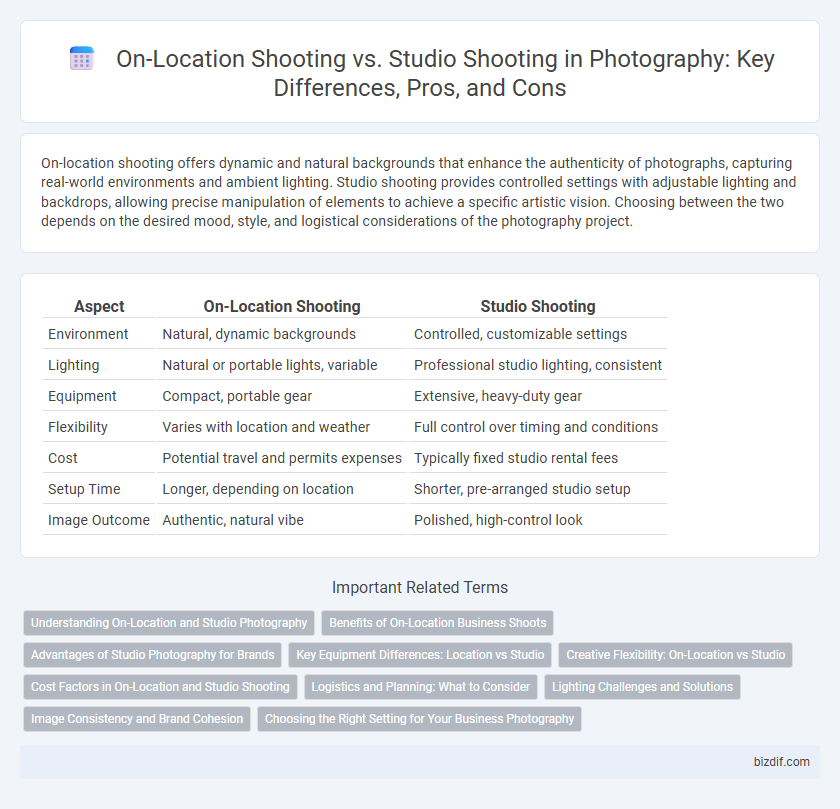On-location shooting offers dynamic and natural backgrounds that enhance the authenticity of photographs, capturing real-world environments and ambient lighting. Studio shooting provides controlled settings with adjustable lighting and backdrops, allowing precise manipulation of elements to achieve a specific artistic vision. Choosing between the two depends on the desired mood, style, and logistical considerations of the photography project.
Table of Comparison
| Aspect | On-Location Shooting | Studio Shooting |
|---|---|---|
| Environment | Natural, dynamic backgrounds | Controlled, customizable settings |
| Lighting | Natural or portable lights, variable | Professional studio lighting, consistent |
| Equipment | Compact, portable gear | Extensive, heavy-duty gear |
| Flexibility | Varies with location and weather | Full control over timing and conditions |
| Cost | Potential travel and permits expenses | Typically fixed studio rental fees |
| Setup Time | Longer, depending on location | Shorter, pre-arranged studio setup |
| Image Outcome | Authentic, natural vibe | Polished, high-control look |
Understanding On-Location and Studio Photography
On-location shooting captures natural light, authentic backgrounds, and dynamic environments, providing diverse visual stories tailored to specific settings. Studio shooting offers controlled lighting, consistent conditions, and customizable backdrops, ensuring precision and creative flexibility for portrait and product photography. Understanding these techniques helps photographers choose the ideal method based on project goals, client needs, and desired aesthetic outcomes.
Benefits of On-Location Business Shoots
On-location business shoots offer a dynamic and authentic environment that enhances brand storytelling by capturing real-world settings and natural lighting, which studio shoots often lack. This approach allows photographers to utilize unique backdrops that reinforce a company's identity and provide context to the products or services showcased. Furthermore, on-location shoots increase engagement by creating compelling visuals that resonate more deeply with target audiences, ultimately boosting marketing effectiveness.
Advantages of Studio Photography for Brands
Studio photography offers brands complete control over lighting, background, and environment, ensuring consistent and high-quality images that align perfectly with brand aesthetics. The controlled setting minimizes external disruptions, enabling precise composition and faster adjustments for multiple product shots or campaigns. This reliability and repeatability enhance efficiency in post-production and support cohesive visual branding across all marketing materials.
Key Equipment Differences: Location vs Studio
On-location shooting requires portable and weather-resistant equipment such as battery-powered lights, lightweight tripods, and versatile reflectors to adapt to varying environmental conditions. Studio shooting relies on heavier, fixed lighting rigs, controlled backdrops, and precise light modifiers like softboxes and grids to maintain consistent image quality. Understanding these equipment differences ensures photographers can capture high-quality images tailored to the shooting environment.
Creative Flexibility: On-Location vs Studio
On-location shooting offers unparalleled creative flexibility by allowing photographers to utilize diverse natural landscapes, ambient lighting, and authentic backgrounds, enhancing narrative depth and visual interest. Studio shooting provides controlled lighting, consistent conditions, and the ability to manipulate every element within the frame, enabling precise artistic execution and repeatable results. Balancing the organic spontaneity of on-location environments with the meticulous control of studio setups empowers photographers to tailor creative approaches to each project's unique visual goals.
Cost Factors in On-Location and Studio Shooting
On-location shooting often incurs higher costs due to permits, travel expenses, and equipment transportation, while studio shooting minimizes these by providing controlled environments with ready access to lighting, backdrops, and power sources. Studio rentals typically come with fixed rates, making budgeting easier compared to variable on-location fees such as site permits and location fees. Additionally, on-location setups may require extra crew time for setup and teardown, increasing labor costs compared to the streamlined processes of studio shoots.
Logistics and Planning: What to Consider
On-location shooting requires thorough logistics planning, including securing permits, scouting for natural light conditions, and arranging transportation and equipment setup at often unpredictable environments. Studio shooting offers controlled settings with consistent lighting, easy access to power sources, and streamlined equipment management, minimizing time constraints and weather dependencies. Prioritizing factors like budget, crew size, and project timeline helps determine whether on-location flexibility or studio reliability better suits the photography assignment.
Lighting Challenges and Solutions
On-location shooting presents lighting challenges such as unpredictable natural light and shadows, requiring portable reflectors and diffusers to balance exposure. Studio shooting offers controlled lighting environments using softboxes, strobes, and grids to create consistent, adjustable illumination. Mastery of both settings involves adapting light modifiers and positioning to achieve optimal image quality regardless of environment.
Image Consistency and Brand Cohesion
On-location shooting offers authentic backgrounds that enhance brand storytelling but can introduce variables affecting image consistency. Studio shooting ensures controlled lighting and setting, resulting in uniform visuals crucial for maintaining brand cohesion across campaigns. Balancing both approaches strategically supports dynamic content while preserving a cohesive brand identity.
Choosing the Right Setting for Your Business Photography
Selecting between on-location shooting and studio shooting depends on your brand's aesthetic and the message you want to convey. On-location shoots offer authentic backgrounds and natural lighting ideal for lifestyle and environmental portraits, while studio shoots provide controlled lighting and consistent settings perfect for product photography and corporate headshots. Evaluating your business objectives, client expectations, and budget ensures the chosen setting enhances visual storytelling and brand identity effectively.
On-Location Shooting vs Studio Shooting Infographic

 bizdif.com
bizdif.com